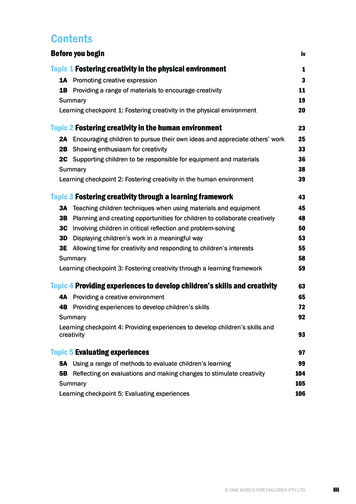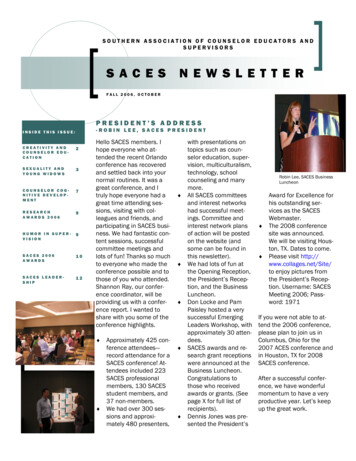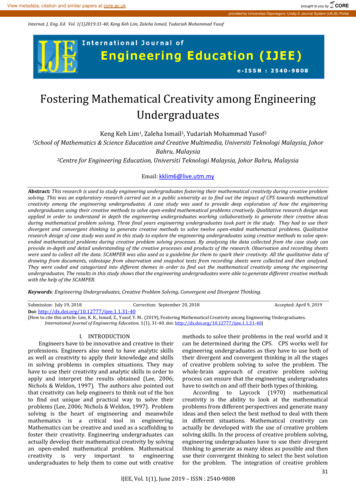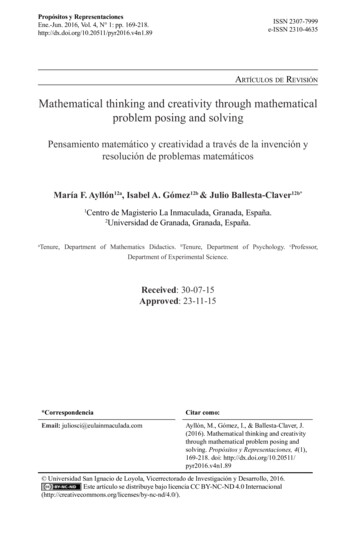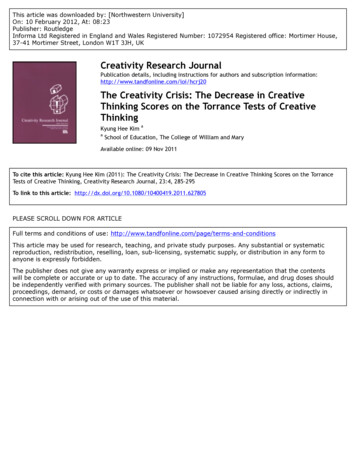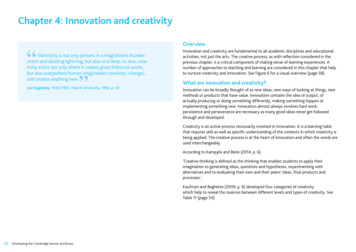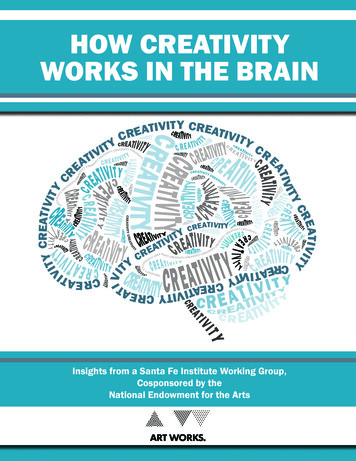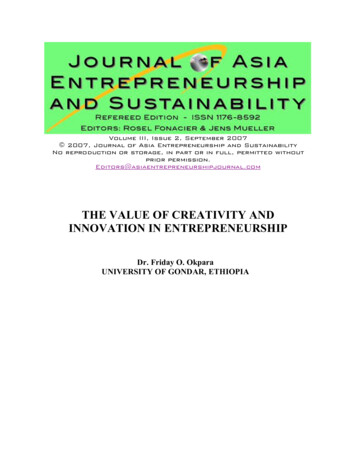
Transcription
Volume III, Issue 2, September 2007 2007, Journal of Asia Entrepreneurship and SustainabilityNo reproduction or storage, in part or in full, permitted withoutprior THE VALUE OF CREATIVITY ANDINNOVATION IN ENTREPRENEURSHIPDr. Friday O. OkparaUNIVERSITY OF GONDAR, ETHIOPIA
INTRODUCTIONDrucker (1985) argued that innovation is the tool of entrepreneurship. In addition, bothinnovation and entrepreneurship demand creativity. Creativity is a process by which asymbolic domain in the culture is changed. New songs, new ideas, new machines arewhat creativity is about Mihaly(1997). Creativity is the ability to make or otherwisebring into existences something new, whether a new solution to a problem, a new methodor device, or a new artistic object or form. Wyckoff (1991) defines creativity as new anduseful. Creativity is the act of seeing things that everyone around us sees while makingconnections that no one else has made. Creativity is moving from the known to theunknown. Culture exerts a negative force on creativity according to Pearce (1974),however, “were it not for creativity, culture itself would not be created.”No entrepreneur or enterprise, however successful and big, can continue to hold aplace of leadership unless it recognizes that modern business operates in a world ofgalloping change which creates new problems, risk and opportunities and for which theyhave to mobilize the enterprise’s resources before changes make their impact felt. To dosuccessfully, the entrepreneur and enterprise should know where this firm is going andhow the firm will get there. This is turn requires a clear definition of the company’sbusiness which will enable it to continually adopt operations to the realities of the marketplace, ‘the very corner stone of survival and growth”Innovation is defined as adding something new to an existing product or process.The key words are adding and existing. The product or process has already been createdfrom scratch and has worked reasonably well. When it is changed so that it works betteror fulfils a different need, then there is innovation on what already exists. Innovation isthe successful exploitation of new ideas.All innovation begins with creative ideas. C creativity is the starting point forinnovation. Creativity is however necessary but not sufficient condition for innovation.Innovation is the implantation of creative inspiration.CREATIVITYCreativity is marked by the ability to create, bring into existence, to invent into a newform, to produce through imaginative skill, to make to bring into existence somethingnew. Creativity is not ability to create out of nothing (only God can do that), but theability to generate new ideas by combining, changing, or reapplying existing ideas. Somecreative ideas are astonishing and brilliant, while others are just simple, good practicalideas that no one seems to have thought, of yet. (Harris, 1998).Everyone has substantial creative ability including you the reader. So you shouldcount yourself and believe it that you are a creative genius. All you need is to bereawakened and be highly committed to creativity. I want you to start thinking now, inthe process something new will flow. Explore that something new today and you will bea different personality tomorrow.Creativity is also an attitude, the ability to accept change and newness, awillingness to play with ideas and possibilities, a flexibility of outlook, the habit ofenjoying the good, while looking for ways to improve it, we are socialized into acceptingonly a small number of permissible or normal things, like chocolate-covered strawberries,
for example. The creative person realizes that there are other possibilities like peanutbutter and banana sandwiches, or chocolate-covered prunes. Harris (1998).Creativity is also a process. Creative person work hard and continually toimprove ideas and solutions, by making gradual alterations and refinements to theirworks. Contrary to the mythology surrounding creativity, very few of creative excellenceare produced with a single stroke of brilliance or in a frenzy of rapid activity. Muchcloser to the real truth are the stories of companies which had to take the invention awayfrom the inventor in order to market it because the inventor would have kept on tweakingit and fiddling with it,, always trying to make it a little better, (Harris, 1998).A product is creative when it is “novel” and “appropriate”. A novel product isoriginal, not predicable. The bigger the concept, and the more the product stimulatesfurther work ideals, the more the product is creative (Stermbering and Lubart). Creativityrequires passion and commitment. Out of the creative is born symbols and myths. Itbrings to our awareness what was previously hidden and points to new life. Theexperience is one of heightened consciousness-ecstasy”- Rollow May.CREATIVE THINKINGCreative thinking has various definitions. Okpara (2000). However, it is the artof generating solution to problems by the force of imagination and reasoning. It is anactivity of the mind seeking to find answer to some of life’s questions. In a dynamic andchanging world, the challenges of man are also not static. They take on new forms andrequire a deep creative thinking approach.It is necessary to know that we live in a thinker’s world. It is therefore, notsurprising to see that the men/women who are ahead are those who see ahead with theeyes of their mind. Men and women who have engaged their minds in resourcefulthinking to generate idea and products, which stand the test of time.Every idea is a product of thinking and every product is the manifestation of ideanaked in a thinker’s mind. These are people who see problems as opportunities toimprove and do something new or something better, people who keep these two vitalquestions on their mind. “What can I do to make things better, or what can I do to makebetter things? This is the product of thinking.In making things better, the goals are usually to improve productivity Andefficiency, achieve speed, enhanced comfort and convenience, influence returnspositively, and so much more. While in making better things, thinking can producevarious alternative leading making better things, thinking can produce various alterativeleading to the evolution of a completely new idea, new production processes, or a totaldeparture from the conventional. Whatever the goal, thinking is an indispensable tool inthe life of all successful entrepreneurs.The celebrated discoveries of man are not accidents. The minds of men/womenwere engaged in creative thinking to deliver the visible products we enjoy today. Namethem: Bill Gate and the computer, Graham Bell and the telephone, Michael Faraday andelectricity, Isaac Newton and physical law of science, the Wight brothers and Aeroplane,Adenuga and Consolidated oil, Atedo peterside and Investment Banking and ThrustCompany, Raymond Depokesi and Dear Communications. The list is endless. You toocan join them as you begin to “ponder the path of your feet, that all your ways may beestablished.”
Thinking begins with engaging yourself in a conversation with yourself byyourself, in yourself. That is to reach a conviction and conclusion as to what steps to takeand what strategies to employ. It is advisable to always have a pen and paper at hand todocument your thoughts. It unveils every illusion around you.The place of asking the right and relevant questions in thinking process cannot beoveremphasized. Questions remain the string tool to provoke the mind to respond toissues ands discover new things. Creative thinking must, therefore, lead to thearticulation of a strategy. A strategy is a way of organizing available resources to achieveresults, what to do, what steps to take, the approach, the timing, positioning, all come toplay when developing strategy. It is a common knowledge that successful entrepreneursemerge not by strength or force but by superior strategy through creative thinking.There are great business opportunities in applying creative thinking to solvingmankind’s crying need for basic products and basic support services –better homes, betterjobs, and a better way of life.There are going to be tremendous opportunities in education because we needfundamental and radical changes in Nigeria if we are going to be competitive with othercountries. However, being able to adapt ideas is what makes an entrepreneur successful.There is nothing wrong with learning from others ideas. Creativity comes in when youexpand upon it, when you take an idea and make it move. The only way forward is tomake our education to be adaptive and qualitative at all levels.THE PRINCIPLES OF CREATIVITYPeople become more creative when they feel motivated primarily by the interest,satisfaction, and challenge of the situation and not by external pressures; the passion andinterest – a person’s internal desire to do something unique to show-case himself orherself; the person’s sense of challenge, or a drive to crack a problem that no one else hasbeen able to solve.Within every individual, creativity is a function of three components:1.Expertise2.Creative thinking skills3.Motivation.Expertise encompasses everything that a person knows and can do in the broaddomain of his or her work- knowledge and technical ability. Creative thinking refers tohow you approach problems and solutions- the capacity to put existing ideas together innew combinations. The skill itself depends quite a bit on personality as well as on how aperson thinks and works. Expertise and creative thinking are the entrepreneur’s rawmaterials or natural resources. Motivation is the drive and desire to do something, aninner passion and interest. When people are intrinsically motivated, they engage in theirwork for the challenge and enjoyment of it. The work itself is motivating. People will bemost creative when they feel motivated primarily by the interest, satisfaction and thechallenge of the work itself-“the labour of love”, love of the work- “the enjoyment ofseeing and searching for an outstanding solution – a break through.Creativity, according to Robert Gahim, consists of anticipation and commitment.Anticipation involves having a vision of something that will become important in thefuture before anybody else has it. Commitment is the belief that keeps one working torealize the vision despite doubt and discouragement.
The entrepreneur is primarily concerned with developing new products, processesor markets, the ability to bring something new, product, processes or markets, the abilityto bring something new into the market. The entrepreneur indulges in original thinkingmore than any other person thinks and he is able to produce solutions that fly in the faceof established knowledge. Entrepreneurs are inclined to be more adaptable and areprepared to consider a range of alternative approaches. They challenge the status quo,which can sometimes bring them into conflict with their colleagues. They dismiss theirdetractors and are sometimes regarded as aloof. Stoner and Wankel(1986).Creative outcomes seldom emerge in an instant: a recognized process is involved,even if it appears to be rather chaotic. It begins with recognition of a problem oranticipation of an opportunity, and then, through understanding the situation andreflecting on the issues, new linkages are contemplated and possible new combinationsof components are aired: From this emerge visible solutions or possibilities that aresubjected to valuation, which may be continuous with judgment being suspended whilethe search process is prolonged in pursuit of genuine newness.Entrepreneurs take bold creative steps but situations encourage creativity.Creativity is, however, enhanced when people have some freedom, but not too much;high internal commitment to the task; but not too high a commitment; high proportion ofintense rewards, but some extrinsic rewards as well; some competition but not winnertake-all competition. Thompson (2001). Entrepreneurial activity depends on the processof innovation following creativity, not on creativity alone.INNOVATIONInnovation is the process of bringing the best ideas into reality, which triggers a creativeidea, which generates a series of innovative events. Innovation is the creation of newvalue. Innovation is the process that transforms new ideas into new value- turning anidea into value. You cannot innovate without creativity. Innovation is the process thatcombines ideas and knowledge into new value. Without innovation an enterprise andwhat it provides quickly become obsolete.The dictionary defines innovation as the introduction of something new ordifferent. Innovation is the implementation of creative inspiration. The NationalInnovation Initiative (NII) defines innovation as “the inter-section of invention andinsight, leading to the creative of social and economic value” Innovation is “value” – thecreation of value adding value to customer’s satisfaction- “delighting the customers”.Innovation is the basis of all competition advantages, the means of anticipating andmeeting customer’s needs and the method of utilization of technology.Innovation is fostered by information gathered from new connections; frominsights gained by journeys into other disciplines or places; from active, collegialnetworks and fluid open boundaries. Innovation arises from organizing circles ofexchange, where information is not just accumulated or stored, but created. Knowledgeis generated a new from connections that were not there before. Wheatley (1994).Innovation requires a fresh way of looking at things, an understanding of people,and an entrepreneurial willingness to take risks and to work hard. An idea doesn’tbecome an innovation until it is widely adopted and incorporated into people’s dailylives. Most people resist change, so a key part of innovating is convincing other people
that your idea is a good one – by enlisting their help, and, in doing so, by helping themsee the usefulness of the idea- Art Fry.Enterprises throughout the world are experiencing what can be legitimatelydescribed as a revolution: rising energy and material costs, fierce internationalcompetition, new technologies, increasing use of automation and computers. All theseare major challenges, which demand a positive response from the entrepreneur andmanagement if the enterprise is to survive and prosper. At a time when finance isexpensive, the firm’s liquidity is bordering on crisis, the need for creativity, andinnovation is more pressing than ever and as competitors fall by the way side, the rewardsfor successful products and process are greater.The instigation of new development is the responsibility of the enterprisesthemselves, which, through experience, are aware of the difficulties created whenundertaking innovative investments in a period of great uncertainty. Innovation calls forspecial entrepreneurial and management skills, the cooperation of a committedworkforce, finance and a climate which will create the optimum overall conditions toencourage success.Joseph Schumpeter (1934) believes that the concept of innovation, described asthe use of an invention to create a new commercial product or service, is the key force increating new demand and thus new wealth. Innovation creates new demand andentrepreneurs bring the innovations to the market. This destroys the existing markets andcreates new ones, which will in turn be destroyed by even newer products or services.Schumpeter calls this process “creative destructions.”THE ENTREPRENEUR AND ENTREPRENEURSHIPWhat are entrepreneurs like? What distinguishes them from other business people? Anentrepreneur is the man or woman who is able to actualize his/her innate potentials anddevelop a character that is not dependent but independent. He/She is that person whoundertakes the voyage of creating value by pulling together a unique package ofresources to exploit an opportunity. He or She has the capacity and capability to buildsomething from practically nothing – initiating, daring, doing, achieving, and building anenterprise. They genuinely believe they have something new and special to offer, either aproduct or a service. To them, life will remain a fantasy unless their dreams areactualized.Entrepreneurs have been described as people who have the ability to see and evaluatebusiness opportunities, gather the necessary resources to take advantage of them andinitiate appropriate action to ensure success. Meredith et al (1991). He is a risk- taker, aman, or woman who bears uncertainty, strikes out on his or her own, and through naturalwit, devotion to duty and singleness of purpose, somehow creates a business andindustrial activity where none exited before.Entrepreneurs are achievement- oriented, like to take responsibility for decisions anddislike repetitive and routine work. Creative entrepreneurs possess high levels of energyand great degrees of perseverance and inauguration, which combined with a willingnessto take moderate, calculated risk, enable them to transform what began as a very simpleill- defined idea or hobby into something concrete.
Entrepreneurs can instill highly contagious enthusiasms in an enterprise. They convey asense of purpose and determination and by so doing, convince others they are where theaction is. Whatever it is – seductiveness, competitiveness, or charisma –entrepreneursknew how to lead an enterprise and give it momentum. The entrepreneur demonstrates aunique combination of energy, originality and shrewdness .He is the main driving forcein the enterprise, a master of motivation and knows how to get the best out of people.Manfred (1997).Most importantly, entrepreneurs are the driving force of any nation ; they are valueadders and represent the wealth of a nation and its potentials to generate employment.The entrepreneur may be a highly educated, trained, and skilled person or he/she may bean illiterate person possessing high business acumen, which others might be lacking.Nevertheless, he/she possesses the following qualities:I.He/She is energetic, resourceful, and alert to new opportunities, able to adjustto changing conditions and willing to assume the risks in change andexpansion.II.He/She introduces technological changes and improves the quality of his/herproduct;III.He/She expands the scale of operations and undertakes allied pursuits, andreinvests his/her profits.The ENTREPRENEUR, therefore includes any person who establishes and manages abusiness enterprise. This is the man or woman who owns a restaurant, fashion centre,boutique, bakery, tailoring outfit, beauty centre, barbering saloon, bookshop, homecatering, business centre, shoemaker, car washing centre, photographing. Others are drycleaning, video centre, telecentres, wholesale trade, coffee and teashop, hotel, producersof yortgurt, fruit juice, bottled and table water, nails, cellophane papers, etc are allentrepreneurs in the contents of this paper. They are all businesses and each has a uniquecontribution to make in the development of the economy.The mix of creativity and irrationality is what makes entrepreneurs tick and accounts formany of their positive contributions. Their visionary abilities and leadership qualitiesstand them out as human colossus. From whatever perspective, the entrepreneur is thekingpin of any business enterprise, for without him or her the wheels of industry cannotmove in the economy. As aptly pointed out by Brozen (1962). “The privateentrepreneurship is an indispensable ingredient in economic development over the longperiod.”Entrepreneurship means much more than starting a new business. It denotes the wholeprocess whereby individuals become aware of the opportunities that exist to empowerthemselves, develop ideas, and take personal responsibility and initiative. In a broadersense, entrepreneurship helps young men and women develop new skills and experiencesthat can be applied to many other challenges in life. Entrepreneurship is therefore a keypriority area with the potential to stimulate job and wealth creation in an innovative andindependent way.
Entrepreneurship provides young people across the nation with valuable life skills andtools to empower them to build sustainable and prosperous futures for themselves andtheir communities. Entrepreneurship is the willingness and ability of an individual to seekout investment opportunities, establish, and run an enterprise successfully. The concept ofentrepreneurship has been associated with several activities concerned with theestablishment and operations of business enterprises. Stevenson (1985) definesentrepreneurship as the process of creating value by putting together a unique package ofresources to exploit an opportunity. Entrepreneurship is the ability to create and buildsomething from practically nothing. It is initiating, doing, achieving, risk- taking, andbuilding an enterprise.Entrepreneurship instills the enterprise culture into the individuals. Enterprise here isdefined as resourcefulness, initiative, drive, imagination, enthusiasm, zest, dash,ambition, energy, vitality, boldness, daring, audacity, courage, get up, and go.Entrepreneurship, therefore, encompasses all the productive functions that are notrewarded immediately by regular wages, interest and rent and non-routine human labour.It is also not investing capital funds along. It is actually, the functions of seekinginvestment, production opportunity, organizing an enterprise to undertake newproduction process, raising capital, hiring labour, allocating resources, and creating newenterprises.THE ELEMENTS OF INNOVATIONInnovation is the successful development of competitive advantage and as such, it is thekey to entrepreneurship. The entrepreneurs are the “dreamers”, who take hands onresponsibility for creating innovation. It is the presence of innovation that distinguishesthe entrepreneur from others. Innovation, must therefore, increase competitivenessthrough efforts aimed at the rejuvenation, renewal, and redefinition of organizations, theirmarkets or industries, if business are to be deemed entrepreneurial.Fiona Fitzpatrick identified the following elements of innovation:1.Challenge: What we are trying to change or accomplish-the “pull”2.Customer focus: Creating value for your customers – the “Push”3.Creativity: Generating and sharing the idea(s)- the “brain”4.Communication: The flow of information and ideas –the “life blood”5.Collaboration: People coming together to work together on the idea(s) - the“heart.”6.Completion: Implementing the new idea-the “muscle”.7.Contemplation; Learning and sharing lessons lead to higher competency-the“ladder”8.Culture: The playing field of innovation includes: Leadership (sees the possibilities and positions the team for action-the rolemodel) People (diverse groups of radically empowered people innovate –thesource of innovation)
9. Basic values (trust and respect define and distinguish an innovativeorganization-the backbone). Innovation values (certain values stoke the fires that make the“impossible” possible-the Spark).Context: Innovation is shaped by interactions with the world.FORMS OF INNOVATIONIn a start-up, the entrepreneur is regarded as the key actor in developing a business idea,marshalling resources, and creating an enterprise to bring a new product or service to themarket. In a competitive business environment, the entrepreneur and the enterpriseshould continue to seek lout now opportunities and make the necessary arrangement toconvert them into new goods and services. Innovation should, therefore, impregnate theentire enterprise for the creation and invention of competitive edge and relevancy in themarket place.Innovation can take several forms:i.Innovation in processes, including changes and improvement tomethods. These contribute to increases in productivity. Which lowerscost and helps to increase demand.ii.Innovation in products or services. While progressive Innovation ispredominant, radical innovation opens up new markets. These lead toincreases in effective demand which encourages increases ininvestment and employment.iii.Innovation in management and work organization, and theexploitation of human resources, together with the capacity toanticipate techniques.Innovation centres on people, culture, structure, process and technology.Innovation is the process through which the entrepreneur converts market opportunitiesinto workable, profitable, and marketable ideas. Innovation is an application ofsomething creative that has a significant impact on an organization, industry or society.Entrepreneurship is the continuing generation of Innovation in response to perceivedopportunities in the business environment.In this approach, entrepreneurship is therefore concerned with newness: newideas, products, services or combinations of resources aimed at meeting the needs ofconsumers more efficiently. Entrepreneurship has been described in terms of the abilityto create something from practically nothing. It is initiating and building an enterpriserather than watching one. It is the knack for sensing opportunities where others seechaos, contradiction and confusion. It is the ability to build a “founding team” tocomplement your own skills and talents. It is know –how to find, marshal and controlresources. Finally, it is a willingness to take calculated risk. Timmons (1989).CHALLENGE FOR INNOVATIONThe place of innovation in commercial success is the development or adoption of newconcepts or idea that leads to any form of increased organizational or social benefit.Innovation is vitally concerned with novel approaches, new ideas, and originality, and itthe means by which ideas are exploited for competitive advantage. The present economic
reform of the Nigerian Government- National Economic Empowerment andDevelopment Strategy (NEEDS) calls for less dependence on imported materials – goodsand services and technology. However, if this dependence is to be successfully broken,three activities should receive adequate priority management attention and thecommitment of resources in this century.1.The need to investigate our latent natural resources for the possibility oftransmitting them into goods and services. This would require a scientificanalysis of the various resources available in the country, the identification oftheir properties, and a determination of the extent to which those properties can beharnessed.2.The need to develop new technology which can be used to process the rawmaterials which may result from the investigation of natural resources suggestedabove and with a view to producing goods and services from them.3.The need to adapt existing technology so as make them accept local materials aresubstitutes. A complete change from an almost total dependence on foreignresearch and technology is source of products is called for.Entrepreneurial success in this century, therefore, depends on the seriousness with whichinnovative activities are undertaken by the enterprises in terms of indigenizing inputsourcing and the development of new indigenous products.The society in general will benefit tremendously from the individual enterprisesundertaking innovative activities rather than leaving such to government agencies. AsMax Weber has observed “when innovation is channeled through autonomous competingenterprises, risk is encouraged and the social curse of unsuccessful innovation can belimited. Society can afford to have an enterprise failure, but society cannot afford to havegovernment failure. Government economic planners proceeding by law or fiat have noflexible mechanism comparable to a market in which they can assess the probabilities ofany given risk and measure its results”. No enterprise, however diversified or big, cantherefore, rest on its oars and past achievements. It becomes imperative for an enterpriseto continuously challenge itself to finding new and better ways of doing the old things orinfact create new ways of doing new things. The new environment may therefore call fornew product designs, new production techniques, composition and packaging which takecognizance of the dynamic business environment.Success in business today demand constant innovation. Generating fresh solutionsto problems and the ability to inherit new products or services for a changing market arepart of the intellectual capital market that gives an enterprise its competitive edge. In adynamic environment, success comes from looking for the next opportunity and havingthe ability to find hidden connections and insights into new products or services, desiredby the customer.While brain-power is the most valuable resource, great ideas are in short supply.Successful entrepreneurs place high premium on attracting and keeping talent becausewealth flows directly from innovation. Creativity is the root of innovation. It is a processand a skill which can be developed and managed throughout the entire enterprise.One of the first steps in creating a culture of innovation is unleashing thecreativity in yourself. The challenge is getting to see the is world with fresh ideas and todevelop fresh solutions. Speed innovating is a proven approach for helping you developbreakthrough solutions in the shortest possible time.
Creative ideas are not enough for your business to survive. You need a processorganization and culture that will help you maximize your creative assets. This isinnovation capability that helps your pull together the best thinking within your business,enabling you to connect the organization dots.Shapiro argues that perpetual and pervasive innovation is the key to long –termsustainable success in the relentless competition for customers. To survive anycompetition, you must rapidly and repeatedly re-invent yourself. The road map to reinvention starts by applying the seven R’s.1.Rethink your underlying assumptions.2.Reconfigure how y
or device, or a new artistic object or form. Wyckoff (1991) defines creativity as new and useful. Creativity is the act of seeing things that everyone around us sees while making connections that no one else has made. Creativity is moving from the known to the unknown. Culture exerts a negative force on creativity according to Pearce (1974),



